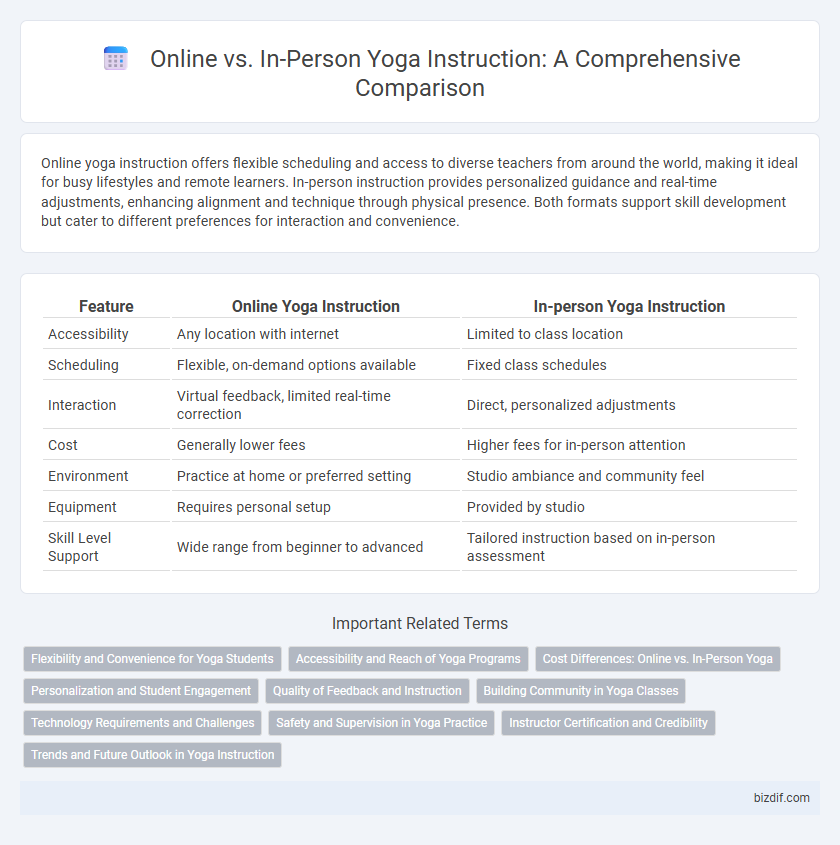Online yoga instruction offers flexible scheduling and access to diverse teachers from around the world, making it ideal for busy lifestyles and remote learners. In-person instruction provides personalized guidance and real-time adjustments, enhancing alignment and technique through physical presence. Both formats support skill development but cater to different preferences for interaction and convenience.
Table of Comparison
| Feature | Online Yoga Instruction | In-person Yoga Instruction |
|---|---|---|
| Accessibility | Any location with internet | Limited to class location |
| Scheduling | Flexible, on-demand options available | Fixed class schedules |
| Interaction | Virtual feedback, limited real-time correction | Direct, personalized adjustments |
| Cost | Generally lower fees | Higher fees for in-person attention |
| Environment | Practice at home or preferred setting | Studio ambiance and community feel |
| Equipment | Requires personal setup | Provided by studio |
| Skill Level Support | Wide range from beginner to advanced | Tailored instruction based on in-person assessment |
Flexibility and Convenience for Yoga Students
Online yoga instruction offers unparalleled flexibility, allowing students to practice anytime and anywhere, which is ideal for those with busy or unpredictable schedules. In-person yoga classes provide structured environments and real-time guidance but require scheduling and commuting, which may limit convenience. Digital platforms enable access to a wide variety of styles and instructors, fostering personalized practice without geographic constraints.
Accessibility and Reach of Yoga Programs
Online yoga instruction significantly expands accessibility by allowing students from diverse geographic locations and time zones to participate in classes without the need for travel. In contrast, in-person instruction offers a tangible community experience but is limited by physical location and class capacity constraints. Digital platforms facilitate a broader reach for yoga programs, enabling instructors to connect with a global audience and accommodate varied schedules.
Cost Differences: Online vs. In-Person Yoga
Online yoga instruction typically offers lower costs due to reduced overhead expenses such as studio rental and commuting fees. In-person yoga classes often involve higher prices reflecting the direct interaction, personalized adjustments, and facility maintenance. Choosing between online and in-person yoga depends on budget preferences and the value placed on hands-on guidance versus convenience.
Personalization and Student Engagement
Online yoga instruction offers personalized guidance through interactive platforms that track individual progress and adapt sequences to students' needs, enhancing engagement despite physical distance. In-person instruction provides real-time, hands-on adjustments and immediate feedback, fostering deeper connection and responsiveness tailored to each student's body and energy. Both methods prioritize customization and active participation but differ in sensory depth and immediacy of personalized interaction.
Quality of Feedback and Instruction
Online yoga instruction provides convenient access to guided sessions but may limit the immediacy and precision of personalized feedback compared to in-person classes. In-person instruction enables instructors to observe subtle body alignments and offer real-time adjustments, enhancing technique and reducing injury risk. High-quality feedback in a physical setting fosters better posture correction and individualized progression, vital for effective yoga practice.
Building Community in Yoga Classes
Online yoga instruction offers accessible platforms for global community building through interactive live sessions and digital forums, fostering connections beyond physical boundaries. In-person classes emphasize immediate personal interactions and energy exchange, cultivating a strong sense of belonging and trust among participants. Combining both approaches can enhance community engagement by balancing flexibility with authentic, face-to-face connection.
Technology Requirements and Challenges
Online yoga instruction demands reliable high-speed internet, quality webcams, and compatible devices to ensure clear video and audio transmission, which can pose accessibility challenges for some students. In-person instruction requires minimal technological tools but depends heavily on physical space and in-person interaction for effective guidance. Technical issues such as latency, software glitches, and limited camera angles can hinder the online learning experience compared to the direct feedback and hands-on adjustments possible in face-to-face sessions.
Safety and Supervision in Yoga Practice
Online yoga instruction offers safety benefits by allowing practitioners to engage in sessions from the comfort of their own space, reducing exposure to external contaminants, but it may limit direct supervision and immediate correction of postures. In-person instruction provides real-time, hands-on adjustments and personalized guidance, significantly enhancing injury prevention and proper alignment. Effective yoga practice safety relies on the instructor's ability to monitor form closely, making in-person supervision superior for maintaining alignment and preventing strain.
Instructor Certification and Credibility
Instructor certification significantly impacts the credibility of both online and in-person yoga instruction, with many reputable platforms requiring alignment with Yoga Alliance or similar recognized bodies. In-person instruction often provides direct, immediate feedback, enhancing certification validation through hands-on adjustments and personalized guidance. Online platforms increasingly integrate certified instructors with verified credentials through video demonstrations, live sessions, and interactive coursework, ensuring credible, flexible learning experiences.
Trends and Future Outlook in Yoga Instruction
The trend toward online yoga instruction continues to expand rapidly, driven by advancements in streaming technology and growing consumer preference for flexible, at-home practice. Hybrid models combining online and in-person classes empower instructors to reach broader audiences while maintaining personalized guidance. Future outlooks project sustained growth in virtual platforms, highlighting integration of AI and virtual reality to enhance interactive yoga experiences.
Online Instruction vs In-person Instruction Infographic

 bizdif.com
bizdif.com